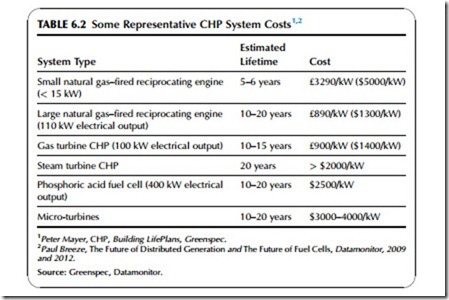COST OF CHP
The economics of CHP depend on the cost of installing the plant with its heat- recovery and generation system, the operating expenses, and the value of the electricity and the heat that it produces. The value of the electricity can be found
by calculating the cost incurred by purchasing a similar quantity of electricity from the local supplier. The value of the heat is more difficult to estimate but can usually be found by estimating the cost of fuel that would have to be pur- chased to generate the heat from an alternative source.
Economics will also depend on the type of consumer that the unit is supplying. Large industrial consumers can buy electricity at wholesale prices from suppliers. The cost of the same electricity when supplied to a domestic consumer can be several times that of the wholesale price. Ther- efore, a domestic CHP system can be relatively expensive and yet still economically viable.
Table 6.2 contains some representative capital costs for CHP systems at the end of the first decade of the 21st century. Some are in pounds sterling and some in U.S. dollars.5 A small reciprocating engine-based system of less than 15 kW is the most expensive in the table with a cost of around £3290/kW or close to $5000/kW. Small CHP gas engines tend to be expensive but the cost falls as the size increases so that a similar system, but with an electrical generating capacity of 110 kW instead of less than 15 kW, has an estimated cost of £890/kW ($1300/kW). This is comparable to the cost of a similarly sized gas turbine– based CHP system that, according to the data in Table 6.2, would cost £900/ kW ($1400/kW). These two large CHP systems would be expected to have a lifetime up to 20 years but the small reciprocating engine operating at around 5000 hours each year or more would have a lifetime of only 5–6 years.
Other systems included in Table 6.2 are a steam turbine–based system with a cost in excess of $2000/kW. This price is for a large steam turbine–based plant and the cost will rise for smaller systems. A commercial fuel cell based on PAFC technology is available in the United States for around $2500/kW. Mean- while, micro-turbines are still relatively expensive at $3000–4000/kW.
To obtain the best economic return it is important to size a CHP system correctly. The unit needs to operate for at least 4000 hours each year to be cost effective, particularly where smaller systems are under consideration. Over- sized engines running at less than full output will often lose some economic benefit, particularly if this involves dumping heat because it is not required.
The figures in Table 6.2 are all for generation systems based on combustion of natural gas. One of the major renewable CHP options involves wood-burning CHP. There are various approaches to this including a straightforward wood- fired boiler generating steam for a steam generator and wood gasification. The typical price for a relatively small wood-based combustion system (500 kW) is around £2000/kW ($3000/kW). Larger systems can cost less, with prices as low as £1200/kW ($1800/kW) feasible.6
